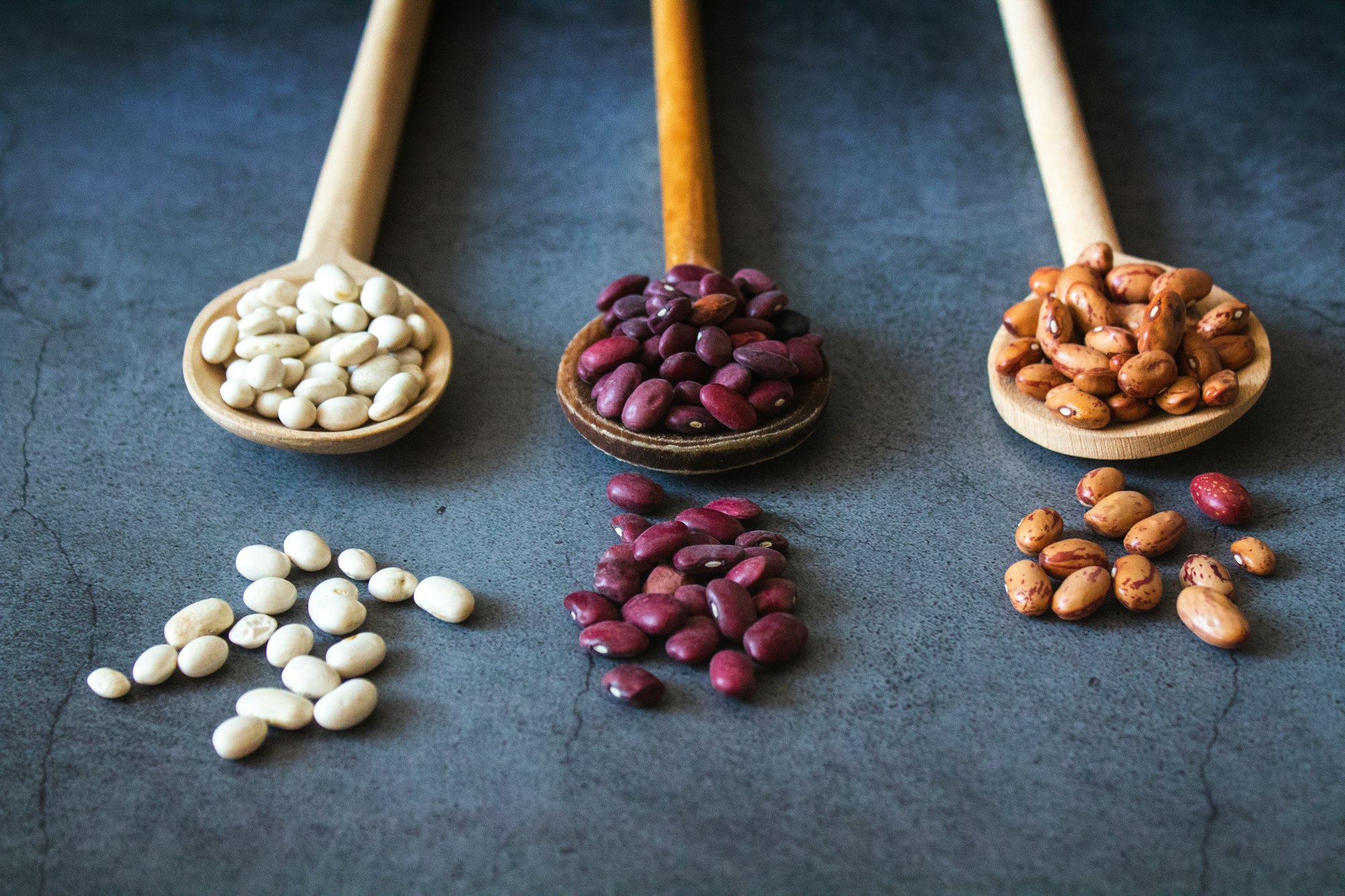The FODMAP diet is an elimination diet designed to identify specific intolerances to certain types of fermentable fibers in food for people with IBS.
Food is one of our greatest pleasures (and eating is a favourite pastime for most of us), but a sensitive gut can mean some foods cause digestive issues. These foods are known as FODMAPs - Fermentable Oligo-Di-Monosaccharides and Polyols.
The acronym encompasses certain carbohydrates (natural sugar molecules) found in foods, but not all carbs are a FODMAP. Research shows that some people might benefit from removing FODMAP foods from their diet to ease digestive discomfort.
Table of contents
- The FODMAP diet in a nutshell
- Why follow a low fodmap diet
- FODMAPs and the gut microbiome
- The risks of cutting out FODMAP foods
- High FODMAP foods
- Low FODMAP foods
- The low FODMAP diet sheet
- How to reintroduce foods on the FODMAP diet
- The final word on FODMAP foods
Even though a low FODMAP diet is thought to be beneficial for people with a specific form of irritable bowel syndrome (IBS), remember that it is a short-term elimination diet. Doctors and dietitians do not recommend following this diet for longer than 4–8 weeks because it is designed to identify FODMAP sensitivities.
☝FACT☝FODMAPs are fermentable carbohydrates that can cause unpleasant gut problems in people who are sensitive to their effects.
1. The FODMAP diet in a nutshell

The FODMAP diet has three steps that typically last four to eight weeks. During this time, by eliminating and reintroducing FODMAP foods, the goal is to identify any sensitivities to specific fermentable fibers in order to control the symptoms of IBS.
FODMAPs are fermentable carbohydrates and are present in a wide variety of foods. While some foods only contain one type of FODMAP, others can contain several. A FODMAP diet plan aims to reduce the intake of high FODMAP foods and has three stages:
- restriction
- reintroduction
- personalisation
The restriction phase is exactly that, strictly avoiding high-FODMAP foods. This phase typically lasts three to eight weeks - Stanford’s Digestive Health Center recommends six weeks. Some people notice positive changes in the first week, while for others, it can take longer, even up to the full eight weeks.
The reintroduction stage involves introducing high-FODMAP foods back into the diet one by one to identify the types and quantities of FODMAPs that can be tolerated. Once this is established, the diet can be personalised so that the amount and type of FODMAPs can be modified to your tolerance.
☝FACT☝What is a FODMAP diet? A low-FODMAP diet is an elimination diet often used to treat IBS patients who experience digestive symptoms after eating these osmotic carbs.
2. Why follow a low FODMAP diet?

A low FODMAP diet is usually prescribed to people with IBS with SIBO (Small Intestinal Bacterial Overgrowth), but it may also be useful for people with gastric symptoms like cramping, pain, flatulence, and bloating.
However, a low FODMAP meal plan isn’t for everyone - it’s a diagnostic elimination diet prescribed by doctors and dietitians. Medical professionals may also prescribe the FODMAP diet for functional symptoms (with no identifiable cause) like:
- abdominal pain
- gas
- bloating
- swollen tummy
- diarrhoea
- constipation
FODMAPs are found in plant foods. The body can’t digest them, so they are broken down by your microbiome - the bacteria living in your gut - and for some, this can result in digestive symptoms. By excluding high FODMAP foods from the diet and then gradually reintroducing them, this diet can help identify if you are sensitive to any specific fermentable carbohydrates.
3. FODMAPs and the gut microbiome
Although there is a positive link between FODMAPs and IBS, it can have a detrimental impact on the gut microbiome. Fermentable carbs feed the healthy microbes in your gut, which allows them to produce important molecules that keep your colon healthy.
FODMAPs are part of the food group known to nourish good bacteria in your microbiome called prebiotics. Made up mostly of plant foods, prebiotics feed important probiotic bacteria, like Bifidobacteria, as well as microbes that produce vitamins and short-chain fatty acids (SCFAs).
These metabolites, which include acetate and butyrate, are important for keeping the gut environment balanced by regulating its pH, providing energy for colon cells, and reducing inflammation. They even help deter opportunistic gut bugs from making you sick.
Although a low-FODMAP diet can help relieve IBS digestive symptoms, there are concerns that low FODMAP foods can negatively impact the gut microbiome. Some studies have shown that a low FODMAP diet can affect the gut microbiome, resulting in a state which has been associated with the development of IBS.
Research also indicates that people with IBS often already have an imbalanced gut microbiome (dysbiosis), and there are concerns that eliminating low-FODMAP foods could make this worse and affect long-term health.
This is because when bacteria break down food in your gut, they can produce gas and other molecules that can irritate the gut lining, causing bloating, gas, flatulence, and cramping. Their activities can also influence how fast stool moves through the gut - in some cases, this can result in constipation or diarrhea.
The take home message here is that a FODMAPs elimination diet plan isn’t for everyone and shouldn’t be followed for weight loss. This diet can significantly change the makeup of your gut’s bacterial ecosystem, and even leave healthy individuals susceptible to opportunistic bacteria and inflammation.
☝FACT☝Prebiotics are mainly plant foods that provide sustenance to beneficial gut microbes, promoting their growth and activity, and ultimately resulting in health benefits.
4. The risks of cutting out FODMAP foods

There are downsides associated with a low FODMAP diet plan, not just for your gut bacteria, but also for you. One of the reasons why a low-FODMAP diet is effective at reducing symptoms like distension, bloating, gas and pain is because you have to stop eating a lot of vegetables, whole grains, beans, and fruit.
Plus, it’s not designed to be a DIY or quick-fix diet. Instead, to get the right results, it needs medical direction and planning. And then there’s the stress it can contribute too, especially as there are links between anxiety, stress, and IBS symptoms.
It’s hard to get right
Let’s face it. The whole IBS FODMAP diet is hard to pull off. Scroll down and check out our FODMAP food list and you’ll see why. It’s extremely restrictive because it takes out gluten, dairy, and some of the most common sources of fiber (fruit, veg, grains, and legumes) that are essential for healthy digestion.
What’s left is a lot of meat, processed foods, and refined carbs. These easy stand-bys are low in fiber and many are high in sugar, which can make them very palatable if your favourite plant foods are restricted during the elimination phase.
☝TIP☝Good FODMAP apps will guide you through a time-restricted elimination period, FODMAP reintroduction, and symptom tracking.
Disordered eating
People who have gastrointestinal diseases are at an increased risk of eating disorders, as are those who undergo severe dietary change. One study of 233 IBS patients at the University College London Hospital found that those who adhered closely to the FODMAP elimination diet displayed eating disorder behaviours.
The low fod map diet is a serious decision that should not be taken lightly. In fact, Britain’s National Institute for Health and Clinical Excellence guidelines state that “the diet should only be undertaken under the advice of a healthcare professional with expertise in dietary management.“
The evidence is controversial
This diet is designed to be a short-term intervention. Basically, it is an elimination diet which is used to identify any of the FODMAPs which may be causing digestive discomfort. After elimination, these foods are reintroduced and GI symptoms are monitored.
While studies do report improvements in abdominal pain and bloating, national health experts are not entirely convinced. In fact, the UK’s National Institute for Health and Clinical Excellence 2015 guidelines for IBS only recommend a FODMAP diet for IBS when other lifestyle and dietary advice has failed:
"There is a lack of scientific research on the use of the low FODMAP diet in people with IBS. Although there is limited, very low-quality evidence of its effectiveness, anecdotal reports indicate that it is being widely used.”
This opinion is echoed elsewhere in the scientific community. A 2016 study found that the effects of a low-FODMAP diet were comparable to those of gut-directed hypnotherapy for IBS patients. In addition, there is a lack of research on whether the FODMAP diet works if you go it alone without a dietitian.
5. High FODMAP foods
Fermentable Oligo, Di-, Mono-saccharides And Polyols are sugars that are fermented by the bacteria in your gut, which can result in gassiness. They also draw water into the intestine. For some people, the combined pressure of gas and extra liquids may cause bloating and cramping.
| Foods to avoid | ||
|---|---|---|
| Dairy | buttermilk, custard, ice cream, sour cream, milk (cow’s, goat’s, sheep’s, condensed and evaporated | |
| Beans and nuts | cashews, lentils, pistachios, soybeans, soy milk, black eyed peas, black eyed peas, broad beans, butter beans, haricot beans, kidney beans, lima beans, split peas | Cereals and grains | barley, rye, wheat |
| Fruit | apples, apricots, blackberries, canned fruit, dried fruits, guava, mango, nectarines, papaya, peaches, pears, plums, prunes, and watermelon | |
| Vegetables | garlic, onions, artichokes, cauliflower, mushrooms, peas, celery, leek, cabbage, shallots, asparagus, chicory root |
6. Low FODMAP foods
Every food group can still be consumed. Animal protein doesn’t contain FODMAPs, and a lot of leafy green vegetables are perfectly fine. Even though it might be hard to live without gluten, there are other gluten-free whole grains you can add to your diet that will help you meet your daily fiber needs.
7. The low FODMAP diet sheet

A FODMAP list is useful for understanding which foods are high in fructans, galactans, fructose, lactose, and polyols. During the elimination phase of the low-FODMAP diet, these are the foods that you can eat.
Low FODMAP diet chart
| Food group | Foods you can include |
|---|---|
| Dairy | low-lactose dairy products like soft cheese, cheddar cheese, parmesan, mozzarella, Greek yoghurt, non-dairy milk alternatives (except soy milk) | Cereals and grains | corn, oats, quinoa, buckwheat, rice, millet, sorghum |
| Fruits | bananas, blueberries, cantaloupe, cranberries, grapes, lemons, limes, strawberries, tangerines |
| Vegetables | beansprouts, bell peppers, chard, carrots, cucumbers, ginger, green beans, kales, lettuce, olives, parsnips, seaweed, spinach. squash, tomatoes, sweet potato, turnips |
| Protein | beef, chicken, poultry, eggs, pork, shellfish, tofu, tempeh, and nut butters |
| Beverages | fruit and vegetable juices, coffee, tea |
8. How to reintroduce foods on the FODMAP
After the elimination phase comes the reintroduction phase, and it’s quite scientific. You can’t just give up the fod diet and eat whatever you want. You need to reintroduce them one by one for several days and record your symptoms. That’s why you need the guidance of a trained dietitian.
Timeline for reintroducing foods
During the reintroduction stage of the low-FODMAP diet, followers are advised to remain on a strict diet. During this phase, small amounts of specific foods are introduced to the diet one by one, usually for three days each. During this time, the person should track all digestive symptoms they experience in a diary.
For example, lactose may be chosen as a specific FODMAP and half a cup of milk may be consumed each day for three days. If symptoms occur or worsen, a dietitian may recommend cutting out milk, but if there are no adverse reactions, the dosage may be increased for a further couple of days to monitor for any symptoms.

Before moving on to the next FODMAP food, it is important to take a break and return to the strict low-FODMAP diet. That’s because symptoms may take a few days to occur. Then, if you were to introduce a new food, it might not be clear which one is causing a problem - something scientists call the crossover effect.
Once individual tolerance is identified, some FODMAPs will still be restricted, but the amount and type will be personalised according to the symptoms during the reintroduction stage. The personalisation stage is important because it increases variety and flexibility, and may reduce the long-term effects of a restrictive diet.
How to monitor symptoms
Monitoring your symptoms doesn’t need to be difficult or time-consuming. Keeping a food diary listing the foods, quantity, and the effects you experience after eating it will help you gain an insight into which foods may be causing you problems.
Alternatively, you could download a FODMAP app which can help you keep a track of your dietary intake and any symptoms. The Atlas Biomed App has a food diary section so you can track and score your meals alongside your Atlas Biomed Microbiome Test results.
The final word on FODMAP

FODMAP is a fancy acronym for Fermentable Oligo, Di-, Mono-saccharides And Polyols. They’re basically carbohydrates found in many foods, but not all carbs are FODMAPs. These sugars are fermented by good gut microbes, which use them to make important molecules called short-chain fatty acids.
However, some people with irritable bowel syndrome may be sensitive to specific FODMAP foods, resulting in abdominal pain, gas, bloating and cramping. In this case, a low-FODMAP meal plan may be recommended by your doctor or dietitian.
That’s because there are some important disadvantages. It’s a restrictive diet that’s hard to follow, and reintroducing foods can be a lengthy and complicated process. Furthermore, this diet can reduce the diversity of your gut microbiome and it should never be used to lose weight.
- Bellini, M and Rossi, A. Is A Low FODMAP Diet Dangerous?, 2018
- Hill, P et al. Controversies and Recent Developments of the Low-FODMAP Diet, 2017
- Marsh, A et al. Does a Diet Low in FODMAPs Reduce Symptoms Associated With Functional Gastrointestinal Disorders? A Comprehensive Systematic Review and Meta-Analysis, 2016
- Mitchell, H et al. Review Article: Implementation of a Diet Low in FODMAPs for Patients with Irritable Bowel Syndrome – Directions for Future Research, 2018
- O’ Keeffe, M and Lomer, M, C, E. Whos Should Deliver the Low FODMAP Diet and What Methods Are Optimal: A Review, 2017
- Peters, S, L et al. Randomised Clinical Trial: The Efficacy of Gut-Directed Hypnotherapy is Similar to that of the Low FODMAP Diet for the Treatment of Irritable Bowel Syndrome, 2016
- Reddel, S et al. The Impact of Low-FODMAPs, Gluten-Free, and Ketogenic Diets on Gut Microbiota Modulation in Pathological Conditions, 2019
- Sloan, T et al. A Low FODMAP Diet is Associated with Changes in the Microbiota and Reduction in Breath Hydrogen but Not Colonic Volume in Healthy Subjects, 2018
- Stanford Hospital and Clinic. The Low FODMAP Diet, 2014
- Thomas, D. Can I tackle the Low FODMAP Diet On My Own?, 2019
- Tuck, C and Barrett, J. Re-Challenging FODMAPs: The Low FODMAP Diet Phase Two, 2017


















